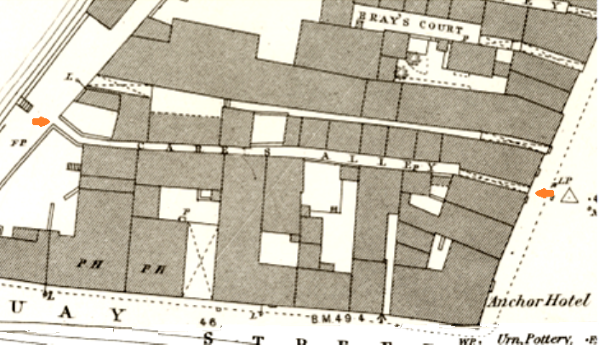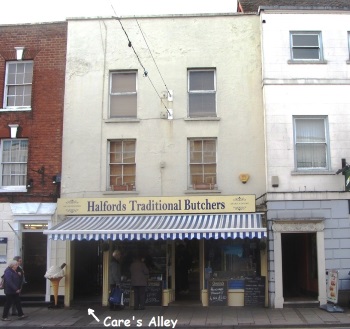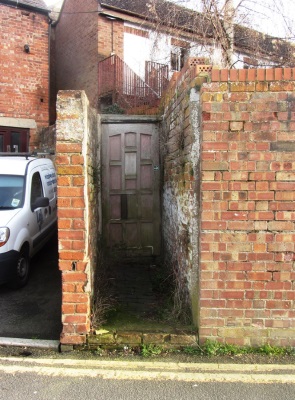Care’s Alley
to Expand
Care’s Alley is unique in that it’s still there but no longer used as such. It is closed by doors at each end, and not claimed as a public right of way, so if it ever was an alley it isn’t now.
The Alley is named after William Care, baker, and the ‘Front House’ was a Care’s bakers until about 1844. It sold all manner of merchandise after that, even becoming a beer-house, the Foresters Arms, between about 1880 and 1917. It is now Halfords Butchers shop.
The alley is still intact and paved with blue bricks. It runs down to Red Lane, to a locked door between the old Healings Mill offices and L&L’s establishment.
By the nineteenth century there were no more than five houses occupied in the alley, though there had been more in earlier days. In 1874 four cottages and a ‘former cottage’ were sold at auction. That was the entire alley. Over the years there were the usual complaints about the condition of the cottages, and official notices to remedy them until in 1936 three cottages were offered for sale and almost at the same time recommended for demolition. This was completed by June 1936. The Alley now has only two, much improved, cottages.

There was a high turnover of occupants, which really isn’t surprising given the description of the Alley by John Rogers in 1905: “This is a very old alley and most of the houses are dark and wretched places to live in, but the rents are low and the poor people are very glad to get low-rented cottages because work is scarce and wages low.”
Looking at census records, few families stayed for ten years. A lot seemed to be young couples in their first homes. Francis and Ann Chapman, in their seventies, are described as paupers. The Daffurn family, in 1861, had seven children. Life must have been very trying in a small, dark cottage.
The Walkers stayed the longest. First recorded there in 1881, generations of Walkers lived in the Alley until the middle of the twentieth century. John Walker was a boatman, as many were in the area. He died in 1908, aged 76. The one blot on his character was being fined two shillings for using profane language. His grandson, also John, was a Sergeant in the Worcestershire Regiment and in 1916 was awarded the Croix de Guerre for distinguished service in the field. A month later, his six year old son was out playing, alone, and fell into the Mill Avon and drowned.
to Expand
This wasn’t the only drowning tragedy in the Alley. In 1868 James Holland, another waterman, sent his thirteen year old son James to sleep on a barge, to make more space in the cottage, but he fell unnoticed into the river and was not missed until the following morning. Such accidents were all too common in Tewkesbury.
In 1934, there was an evacuation of the cottages when the British Legion building in Quay Street, which backed onto the Alley, caught fire and was gutted. Luckily, there were no injuries and the fire was contained to the one building.
In 1892, after a complaint about the state of the Alley, the owners, Tewkesbury Brewery Company, asked the Council to pave it, claiming that they had paved other private alleys. The Surveyor denied this, and refused. Negotiations must have carried on, though, because in 1901 it was paved with blue bricks, the mark of a public right of way. In 1938 a complaint was made that a door had been fixed to the alley and the Town Clerk was instructed to order its removal. By 1949 there were four doors there and the owners were told that they were blocking a right of way and they were given fourteen days to take them down. This they must have done, because eight years later Mr Hill, who lived in the front house, complained that on dark winter evenings the alley was full of courting couples, who were creating a nuisance. The Council approved fitting a door to the alley, and it has been closed off ever since.The Alley’s neighbour on the north side was Johns’ Brewery. Mr Johns lived in 46 High Street (Now Subway) and the side passage led to the brewery, established there by 1770. After the death of the Thomas Johns, Master Brewer, in 1864 the enterprise was continued under the name of Tewkesbury Original Brewery until 1875, when brewing transferred to Quay Street and the buildings became stores. Several residents of the alley were Brewery Workers and the brewery became owner of all the Care’s Alley cottages. This would have ended in 1890 when the brewery closed and sold up.
It was always a quiet alley, and it remains closed off and secret. Almost everything else has gone.




Comments